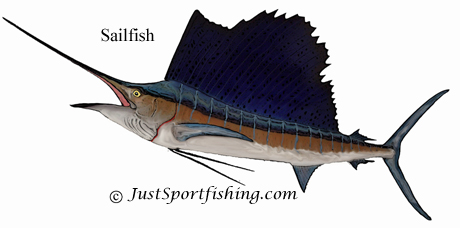|
|

How
to fish for Sailfish
Sailfish inhabits tropical and subtropical waters near landmasses. Sailfish are usually caught in the top 200 feet of water. Sailfish usually travel alone or in small groups. They appear to feed mostly along the edges of reefs or current eddies. The most action is found where sailfish are located on or near the surface. They eat squid, octopus, mackerels, tunas, jacks, herring, ballyhoo, needlefish, flying fish, mullet and other small fishes. Its fighting ability and spectacular aerial acrobatics endear the sailfish to the saltwater angler, but it tires quickly and is considered a light tackle species. Fishing methods include trolling with strip baits, whole mullet or ballyhoo, plastic lures, feathers or spoons, as well as live bait fishing and kite fishing from boats using jacks, mullet and other small live baits. The larger sailfish up to 150 pounds are usually taken during the Fall but for pure volume of 80 to 100 pound fish, December through June tends to be the rule.
A tackle set-ups for Sailfish is a Shimano TLD 20, spooled with over 400 yards of Berkley Big Game 30 pound test, accompanied with a seven foot, medium action Oceanmaster rod. Keeping 4-5 pounds of drag set in the strike position, most Sailfish stay inside of 150 yards from the boat and are brought to the stern within 20 minutes. I use Berkley Big game fishing line doesn't have much stretch or memory and it is abrasive resistant. Tie a 5/0 Lazer sharp Eagle Claw Salmon hook directly to the main line. You can bring in the fish within 20 minutes and the line holds up very well, and you get a lot more hits that way. Re-tie your hook after each fish caught to be safe from any nicks or chaff on your line.
Putting the right bait on your hook is critical to your success. Most fishermen use Ballyhoo, Pilchards, and Threadfin Herring, and the best is the valuable goggle eye.
Drifting for Sailfish requires dropping your baits back on the strike. Sailfish are very sensitive as they pick up your bait, if your bumping in and out of gear a Sailfish can come up on your bait, mouth it, and if your drag is tight the boat will pull it from his mouth and he might not come back. Only keep your fishing reel at 4 to 5 pounds drag.
A Sailfish that's to tired to swim away after the fight will sink. So what do you do when you get a Sailfish that looks half dead at your boat side? You need to resuscitate him. Put on your gloves, grab his sandpaper like spindle beak, remove your hook and hold him boat side, preferably with the boat in gear. You need to revive him for 5 to 10 minutes before you let him go.

|
JustSportfishing.com

|


